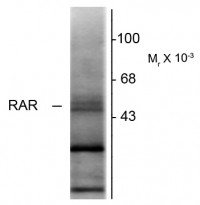ARG52414
anti-Retinoic Acid Receptor beta antibody [336]
anti-Retinoic Acid Receptor beta antibody [336] for Western blot and Human,Rat
Cancer antibody; Gene Regulation antibody; Signaling Transduction antibody
Overview
| Product Description | Mouse Monoclonal antibody [336] recognizes Retinoic Acid Receptor beta |
|---|---|
| Tested Reactivity | Hu, Rat |
| Predict Reactivity | Ms, Dog, Gpig, NHuPrm |
| Tested Application | WB |
| Host | Mouse |
| Clonality | Monoclonal |
| Clone | 336 |
| Isotype | IgG1 |
| Target Name | Retinoic Acid Receptor beta |
| Antigen Species | Human |
| Immunogen | Synthetic peptide corresponding to amino acid residues from the N-terminal region conjugated to KLH |
| Conjugation | Un-conjugated |
| Alternate Names | HBV-activated protein; NR1B2; RAR-epsilon; Retinoic acid receptor beta; RAR-beta; HAP; Nuclear receptor subfamily 1 group B member 2; RRB2; MCOPS12 |
Application Instructions
| Application Suggestion |
|
||||
|---|---|---|---|---|---|
| Application Note | Specific for the ~48k RAR-β isotype. * The dilutions indicate recommended starting dilutions and the optimal dilutions or concentrations should be determined by the scientist. |
Properties
| Form | Liquid |
|---|---|
| Purification | Protein G purified |
| Buffer | 10 mM HEPES (pH 7.5), 150 mM NaCl, 0.1 mg/ml BSA and 50% Glycerol |
| Stabilizer | 0.1 mg/ml BSA, 50% Glycerol |
| Storage Instruction | For continuous use, store undiluted antibody at 2-8°C for up to a week. For long-term storage, aliquot and store at -20°C. Storage in frost free freezers is not recommended. Avoid repeated freeze/thaw cycles. Suggest spin the vial prior to opening. The antibody solution should be gently mixed before use. |
| Note | For laboratory research only, not for drug, diagnostic or other use. |
Bioinformation
| Database Links | |
|---|---|
| Gene Symbol | RARB |
| Gene Full Name | retinoic acid receptor, beta |
| Background | Retinoic Acid (RA; active metabolite of vitamin A) plays a prominent role in regulating the transition of proliferating precursor cells (such as carcinoma cells and neuronal precursors) to postmitotic differentiated cells (Joshi et al., 2005). The Retinoid X receptors (RXRs) family (RXRα, β and γ) preferentially bind 9-cis-RA and regulate gene transcription by forming heterodimers with a second family of RA receptors (RARs). RAs have been suggested to potentially play a therapeutic role in cervical cancer (Abu et al., 2005). RAs are known to play key roles in neuronal development and an increasing body of evidence indicates that retinoid signaling may regulate synaptic plasticity and associated learning and memory behaviors (Lane and Bailey, 2005). |
| Research Area | Cancer antibody; Gene Regulation antibody; Signaling Transduction antibody |
| Calculated MW | 50 kDa |
Images (1) Click the Picture to Zoom In








